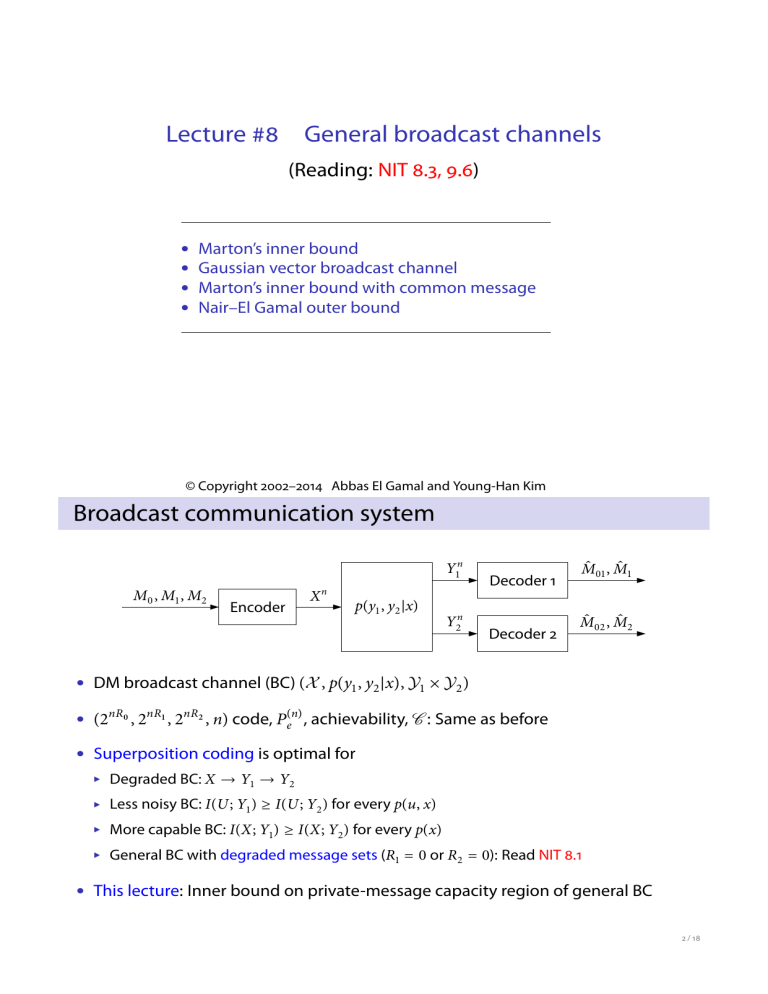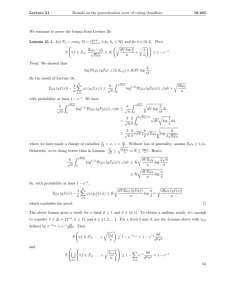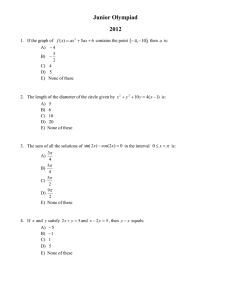Lecture General broadcast channels Broadcast communication system
advertisement

Lecture
General broadcast channels
(Reading: NIT ., .)
∙
∙
∙
∙
Marton’s inner bound
Gaussian vector broadcast channel
Marton’s inner bound with common message
Nair–El Gamal outer bound
© Copyright – Abbas El Gamal and Young-Han Kim
Broadcast communication system
Yn
M , M , M
Encoder
Xn
p(y , y |x)
Yn
Decoder
Decoder
̂ , M
̂
M
̂ , M
̂
M
∙ DM broadcast channel (BC) (X , p(y , y |x), Y × Y )
∙ (nR , nR , nR , n) code, Pe(n) , achievability, C : Same as before
∙ Superposition coding is optimal for
Degraded BC: X → Y → Y
Less noisy BC: I(U; Y ) ≥ I(U; Y ) for every p(u, x)
More capable BC: I(X; Y ) ≥ I(X; Y ) for every p(x)
General BC with degraded message sets (R = or R = ): Read NIT .
∙ This lecture: Inner bound on private-message capacity region of general BC
/
Marton’s inner bound
∙ A simple inner bound: (R , R ) is achievable for the DM-BC p(y , y |x) if
R < I(U ; Y ),
R < I(U ; Y )
for some pmf p(u )p(u ) and function x(u , u )
∙ Marton’s coding scheme: Allows U and U to be dependent
Theorem . (Marton )
(R , R ) is achievable if
R < I(U ; Y ),
R < I(U ; Y ),
R + R < I(U ; Y ) + I(U ; Y ) − I(U ; U )
for some pmf p(u , u ) and function x(u , u )
∙ Optimal for semideterministic BC (Y = y (X )) and Gaussian vector BC
/
Semideterministic BC
∙ Semideterministic BC (Y = y (X)): Set U = Y
The capacity region is the set of (R , R ) such that
R ≤ H(Y ),
R ≤ I(U; Y ),
R + R ≤ H(Y |U) + I(U; Y )
for some p(u, x)
∙ Deterministic BC (Y = y (X), Y = y (X)): Further set U = Y
The capacity region is the set of (R , R ) such that
R ≤ H(Y ),
R ≤ H(Y ),
R + R ≤ H(Y , Y )
for some p(x)
/
Example: Blackwell channel
Y
Y
X
X
Y
R
R
H(/)
R
/
/
/ /
∙
Proof
of achievability
∙
H
C ()
C ()
/
=
= (
)
≤ ( )
≤ ( / )
+
≤
Use multicoding and the mutual covering lemma
un (l )
R
C ()
̃ −R )
n(R
C (m )
⋃
( )+
∈[/
/ ]
C (nR )
̃
n R
un (l )
̃
n(R −R )
C ()
Tє(n)
(U , U )
C (nR )
̃
n R
/
Proof of achievability
∙ Codebook generation: Fix p(u , u ) and x(u , u )
̃
For each m ∈ [ : nR ] generate a subcodebook C (m ) consisting of n(R −R ) sequences
̃
̃
n
un (l ) ∼ ∏i= pU (ui ), l ∈ [(m − )n(R −R ) + : m n(R −R ) ]
Similarly, generate C (m ), m ∈ [ : nR ]
C ()
un (l )
C ()
C ()
̃
n(R −R )
C (m )
C (nR )
̃
n R
un (l )
̃
n(R −R )
C ()
C (nR )
̃
n R
/
Proof of achievability
∙ Codebook generation: Fix p(u , u ) and x(u , u )
For each (m , m ), find (l , l ) such that un (l ) ∈ C (m ), un (l ) ∈ C (m ),
(un (l ), un (l )) ∈ Tє(n)
If no such pair exists, choose (l , l ) = (, )
Generate xn (m , m ) as xi (m , m ) = x(ui (l ), ui (l )), i ∈ [ : n]
C ()
un (l )
C ()
C ()
̃ −R )
n(R
C (m )
C (nR )
̃
n R
un (l )
̃
n(R −R )
C ()
Tє(n)
(U , U )
C (nR )
̃
n R
/
Proof of achievability
∙ Encoding:
To send a message pair (m , m ), transmit xn (m , m )
C ()
un (l )
C ()
C ()
̃
n(R −R )
C (m )
C (nR )
̃
n R
un (l )
̃
n(R −R )
C ()
C (nR )
̃
n R
/
Proof of achievability
∙ Decoding:
̂ j such that (unj (lj ), yjn ) ∈ Tє(n) for some unj (lj ) ∈ Cj (m
̂ j)
Decoder j = , finds unique m
C ()
un (l )
C ()
C ()
̃ −R )
n(R
C (m )
C (nR )
̃
n R
un (l )
̃
n(R −R )
C ()
C (nR )
̃
n R
/
Analysis of the probability of error
∙ Consider P(E) conditioned on (M , M ) = (, )
∙ Let (L , L ) denote the pair of chosen indices
∙ Error events for decoder :
for all (Un (l ), Un (l )) ∈ C () × C (),
E = (Un (l ), Un (l )) ∉ Tє(n)
E = (Un (L ), Yn ) ∉ Tє(n) ,
̃
E = (Un (l ), Yn ) ∈ Tє(n) (U , Y ) for some l ∉ [ : n(R −R ) ]
Thus, by the union of events bound,
P(E ) ≤ P(E ) + P(Ec ∩ E ) + P(E )
/
Mutual covering lemma (U = )
∙ Let (U , U ) ∼ p(u , u ) and є < є
∙ For j = , , let Ujn (mj ) ∼ ∏ni= pUj (uji ), mj ∈ [ : nrj ], be pairwise independent
∙ Assume that {Un (m )} and {Un (m )} are independent
Un
Un
Un (m )
Un (m )
/
Mutual covering lemma (U = )
∙ Let (U , U ) ∼ p(u , u ) and є < є
∙ For j = , , let Ujn (mj ) ∼ ∏ni= pUj (uji ), mj ∈ [ : nrj ], be pairwise independent
∙ Assume that {Un (m )} and {Un (m )} are independent
Lemma . (Mutual covering lemma)
There exists δ(є) → as є → such that
lim P(Un (m ), Un (m )) ∉ Tє(n) for all m ∈ [ : nr ], m ∈ [ : nr ] =
n→∞
if r + r > I(U ; U ) + δ(є)
∙ Proof: See NIT Appendix A
∙ This lemma extends the covering lemma:
For a single Un sequence (r = ), r > I(U ; U ) + δ(є) as in the covering lemma
Pairwise independence: linear codes for finite field models
/
Analysis of the probability of error
∙ Error events for decoder :
E = (Un (l ), Un (l )) ∉ Tє(n)
for all (Un (l ), Un (l )) ∈ C () × C (),
E = (Un (L ), Yn ) ∉ Tє(n) ,
̃
E = (Un (l ), Yn ) ∈ Tє(n) (U , Y ) for some l ∉ [ : n(R −R ) ]
∙ By the mutual covering lemma (with r = R̃ − R and r = R̃ − R ),
̃ − R ) + (R
̃ − R ) > I(U ; U ) + δ(є )
P(E ) → if (R
∙ Since Ec = {(Un (L ), Un (L ), X n ) ∈ Tє(n)
},
by the conditional typicality lemma, P(Ec ∩ E ) →
∙ By the packing lemma, P(E ) → if R̃ < I(U ; Y ) − δ(є)
∙ Similarly, P(E ) → if R̃ < I(U ; Y ) + δ(є)
∙ Using Fourier–Motzkin to eliminate R̃ and R̃ completes the proof
/
Relationship to Gelfand–Pinsker
∙ Fix p(u , u ) and x(u , u )
∙ Consider R = I(U ; Y ) − I(U ; U ) − δ(є) and R = I(U ; Y ) − δ(є)
∙ Marton scheme for communicating M is equivalent to G–P for p(y |u , u )p(u )
p(u )
Un
M
Encoder
Un
Xn
x(u , u )
p(y |x)
Yn
Decoder
̂
M
∙ The corner point (R = I(U ; Y ), R = I(U ; Y ) − I(U ; U )) achieved similarly
∙ The rest of the pentagon region is achieved by time sharing
/
Application: Gaussian BC
Z
M
M -encoder
Xn
Yn
Xn
M
M -encoder
Yn
Xn
Z
̄
∙ Decompose X into the sum of independent X ∼ N(, αP) and X ∼ N(, αP)
̄
∙ Send M to Y = X + X + Z : R < C(αP/(αP
+ N )) (treat X as noise)
∙ Send M to Y = X + X + Z : R < C(αP/N ) (writing on dirty paper)
Substitute U = X and U = βU + X , β = αP/(αP + N ) in Marton
∙ This coding scheme works even when N > N (unlike superposition coding)
/
Gaussian vector broadcast channel
Z
M , M
Encoder
Xn
Yn
G
Yn
G
̂
M
Decoder
̂
M
Decoder
Z
∙ Average power constraint: ∑ni= xT(m , m , i)x(m , m , i) ≤ nP
∙ Z , Z ∼ N(, Ir )
∙ Channel is not degraded in general (superposition coding not optimal)
∙ Marton coding (vector writing on dirty paper) is optimal, however
/
Capacity region
∙ R : (R , R ) such that
R
|G K GT + G K GT + Ir |
,
R < log
|G K GT + Ir |
R <
log |G K GT + Ir |
R
C
R
for some K , K ⪰ with tr(K + K ) ≤ P
∙ R : (R , R ) such that
R < log |G K GT + Ir |,
R
|G K GT + G K GT + Ir |
R < log
|G K GT + Ir |
for some K , K ⪰ with tr(K + K ) ≤ P
Theorem . (Weingarten–Steinberg–Shamai )
C is the convex closure of R ∪ R
/
Proof of achievability for R
Z
M
M -encoder
Xn
X
M
M -encoder
n
Xn
Yn
G
Yn
G
Z
∙ Decompose X into the sum of independent X ∼ N(, K ) and X ∼ N(, K )
∙
|G K GT + G K GT + Ir |
Send M to Y = G X + G X + Z : R < log
|G K GT + Ir |
∙ Send M to Y = G X + G X + Z : R < log |G K GT + Ir | (vector WDP)
∙ R is achieved similarly
/
Marton’s inner bound with common message
Theorem . (Marton , Liang )
(R , R , R ) is achievable if
R + R < I(U , U ; Y ),
R + R < I(U , U ; Y ),
R + R + R < I(U , U ; Y ) + I(U ; Y |U ) − I(U ; U |U ),
R + R + R < I(U ; Y |U ) + I(U , U ; Y ) − I(U ; U |U ),
R + R + R < I(U , U ; Y ) + I(U , U ; Y ) − I(U ; U |U )
for some p(u , u , u ) and function x(u , u , u )
∙ Proof of achievability: Superposition coding + Marton’s coding
∙ Tight for all classes of BCs with known capacity regions
∙ Even for R = , larger than Marton’s inner bound with U = (Theorem .)
/
Nair–El Gamal outer bound
Theorem . (Nair–El Gamal )
If (R , R , R ) is achievable, then
R ≤ min{I(U ; Y ), I(U ; Y )},
R + R ≤ I(U , U ; Y ),
R + R ≤ I(U , U ; Y ),
R + R + R ≤ I(U , U ; Y ) + I(U ; Y |U , U ),
R + R + R ≤ I(U ; Y |U , U ) + I(U , U ; Y )
for some p(u )p(u )p(u |u , u ) and function x(u , u , u )
∙ Tight for all BCs with known capacity regions that we discussed so far
∙ Does not coincide with Marton’s inner bound (Jog–Nair )
∙ Not tight in general (Geng–Gohari–Nair–Yu )
/
Summary
∙ Marton’s inner bound:
Multidimensional subcodebook generation
Generating correlated codewords for independent messages
∙ Mutual covering lemma
∙ Connection between Marton coding and Gelfand–Pinsker coding
∙ Writing on dirty paper achieves the capacity region of the Gaussian vector BC
∙ Nair–El Gamal outer bound
/
References
Geng, Y., Gohari, A. A., Nair, C., and Yu, Y. (). The capacity region for two classes of product broadcast
channels. In Proc. IEEE Int. Symp. Inf. Theory, Saint Petersburg, Russia.
Jog, V. and Nair, C. (). An information inequality for the BSSC channel. In Proc. UCSD Inf. Theory Appl.
Workshop, La Jolla, CA.
Liang, Y. (). Multiuser communications with relaying and user cooperation. Ph.D. thesis, University of
Illinois, Urbana-Champaign, IL.
Marton, K. (). A coding theorem for the discrete memoryless broadcast channel. IEEE Trans. Inf.
Theory, (), –.
Nair, C. and El Gamal, A. (). An outer bound to the capacity region of the broadcast channel. IEEE
Trans. Inf. Theory, (), –.
Weingarten, H., Steinberg, Y., and Shamai, S. (). The capacity region of the Gaussian multiple-input
multiple-output broadcast channel. IEEE Trans. Inf. Theory, (), –.
/







